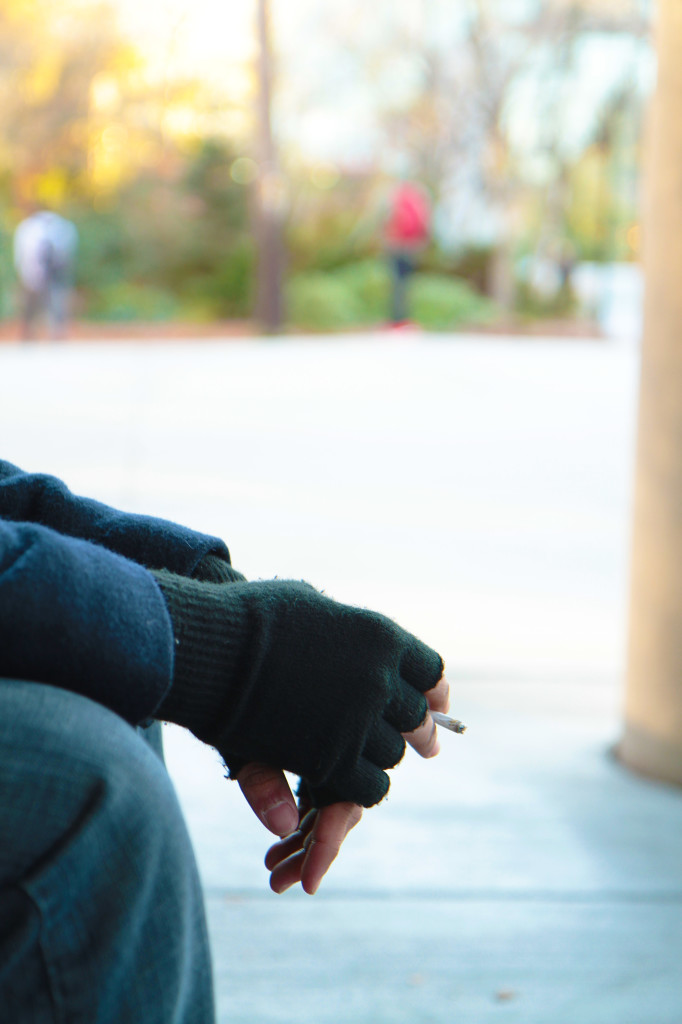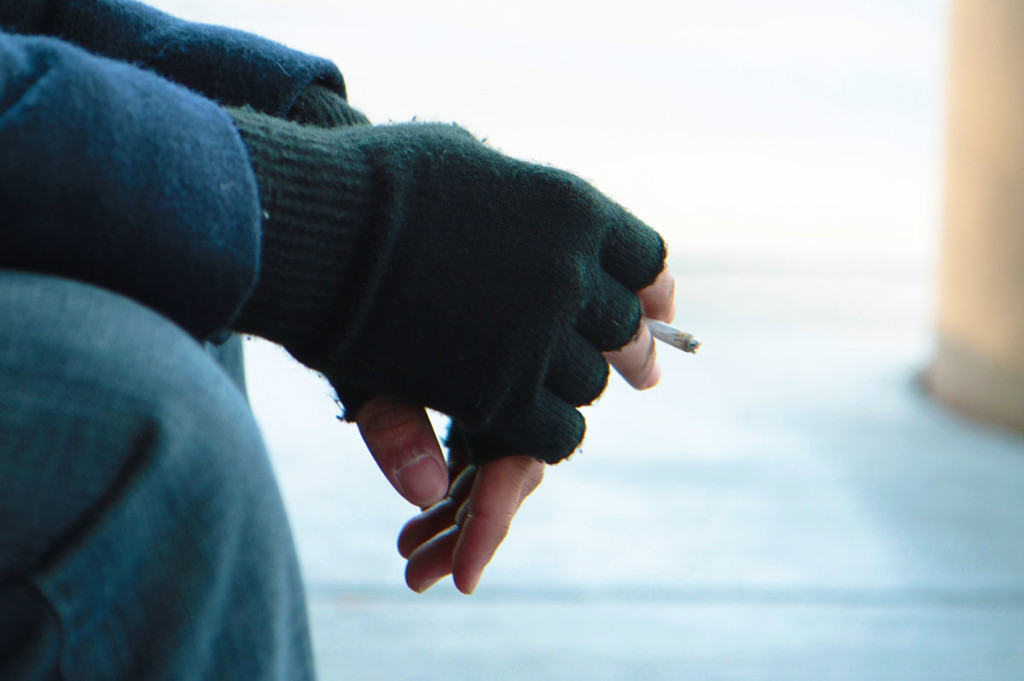SGSU President Eric Chalmers and Chair of the Tobacco-Free Campus Exploration Committee (TFCEC) Austin Kawano explained that the 1-day trial for a tobacco-free campus was an exploration to see what Seattle U would look like without tobacco. But many people didn’t pay any attention to the trial.
The Tobacco-Free 1-Day Trial was hosted in conjunction with The Great American Smokeout, which is the national event on the third Thursday of November each year. These American Cancer Society marks this day to encourage smokers to plan to quit or quit even for one day, ideally raising awareness of lung cancer.
In an email to the entire student body, Kawano encouraged students to refrain from smoking on campus on this day, as well as to ask those who are smoking to move themselves off campus for the day out of consideration for others.

A junior who wished to remain unnamed, believes that the ultimate decision to ban smoking on campus is up to the leaders of the University. This student continued to smoke outside of the law building on November 21st, SGSU’s 1-day trial of a smoke free campus.
It appears most students continued to smoke that day.
The experiment appeared to be a departure from previously reported SGSU plans—Chalmers explained to The Spectator in its Oct. 30 issue that SGSU would place the smoke-free campus initiative on hold pending its inclusion in the State of the Student Survey in January, even going so far as to encourage students to think of the survey as a ballot. In a reversal, the smokeout seemed to be an endorsement of the ban on SGSU’s behalf.
This event was not planned by the committee or SGSU until Seattle and King county public health educators contacted Kawano suggesting Seattle U take part in The Great American Smokeout, as many colleges across the country take part in this event.
The Tobacco-Free Campus Exploration Committee met after hearing about the Great American Smokeout and supported the event. The committee was then in contact with the Student Bar Association (SBA) to ensure the event was advertised in the law school. TFCEC then went to SGSU for approval, and representatives supported the proposal.
“We have heard from quite a few people that really are affected by the presence of second-hand smoke,” said Chalmers. “It really does harm their learning environment, so anytime we have students bring that to us it’s something we’re going to look into.”
The Tobacco-Free initiative is not a new project to SGSU this year.
Chalmers explained that the Student Government archives show that this issue was brought to the table in 2005 and has been inherited from president to president. Last year’s SGSU President Nicole Gaddie listed a tobacco-free campus in her stated goals, and the momentum of the movement has driven the committee to action this year.
For some, however, it hasn’t been effective.
“I don’t even know what SGSU does, and I’m a senior,” said senior Sy Bean.
“I think SGSU could push their attention in other areas or focus more [on] the divestment campaign. This has been happening for years now and nothing has happened, so I feel like they are beating a dead horse. If the initiative passes I’ll probably just laugh and keep smoking on campus. I’m happy for SGSU that they want to allocate their time and energy to that, but I think they are wasting their time.”
Kawano briefly worked with Gaddie last year on promotion, and at the end of last year the TFCEC was formed. The impetus for the formation of the committee lay in the fact that the issue has been prevalent in student survey responses over the years. One problem with the surveys is a distorted perception of the number of smokers on campus.
“We want to address perception versus reality,” Kawano said. “From surveys the perception that SU students smoke daily was 70 percent, but in reality the people who smoke daily was reported at 3 percent. That is a giant misperception and it is something the committee wants to address.”
SBA President Rochelle Nelson added that, according to feedback she’s received, the majority of law students appear to vehemently oppose the ban.
“From what we’ve seen from the students, a pretty big majority are against the ban. That’s the position of the law school, but we’re still trying to figure out where grad and undergrad students are,” said Nelson.
SGSU has received a lot of feedback from students about the 1-day trial and not all of it has been good. Sentiments ranged from support, to confusion about the purpose of the exploration, to anger at the purpose of the proposal. Some critique centers on the enforcement of the 50-foot rule, prohibiting smoking within 50 feet of a building entrance, which is not currently enforced.
“I’m just a little confused about what they are trying to accomplish,” said Bean. “I don’t really see a clear direction in what they want to accomplish besides trying to execute something that sounds good on
the surface.”
Seattle U senior and groundskeeper Tyler Russell applauded the effort, but his concerns expand beyond those of health: he argued that a tobacco-free campus would be a cleaner campus.
“If the campus goes tobacco-free there won’t be cigarette butts on walkways or in the gardens,” said Russell. “There are always butts or cigarette boxes by the ashtrays because people never seem to put them in the ashtrays. By far the most trash we pick up on campus is cigarette butts.”
Senior Lauren Byun, on the other hand, doesn’t feel the trial day was a success.
“There are good intentions behind it, but I’m not sure how effective it was,” said Byun. “I feel like you can’t force somebody to change their habits. I think the student government should focus on something else, personally.”
Kawano had an answer for her.
“Since we are in an urban campus on Capitol Hill there are many people around us who smoke or use tobacco,” said Kawano. “Some students have voiced concerns about that, but that still needs to be further explored.”
Chalmers, for his part, takes issue with the implication that SGSU is overly focused on the tobacco-free effort.
“There are a lot of other issues we are working on,” Chalmers said. “I don’t think [the tobacco-free campus initiative] is particularly a passion shared by all of SGSU, but because it has been carrying on for so long that it’s something that has been a very voiced student concern for many years.”
SGSU hears theses student concerns via survey, email, and public comment in meetings.
Chalmers even reports that students come up to him or into the office to voice their concerns in person.
“We had a student two weeks ago come in and say ‘I’m a freshman, I’m asthmatic, and the high school I was at was smoke-free, and it really made it a much better environment for me. I’m physically affected.’ For us, hearing that, we recognize part of our oath of office is to protect the students of Seattle University. We take that very seriously.”
Oath aside, Chalmer made sure to reiterate that attention is not solely focused on the tobacco initiative.
“SGSU attention is very focused elsewhere. There are a lot of other things we are working on. Yes, this is an issue that is being talked about a lot, but there are a lot of other things in my emails. We are working on getting another staff member for the Disabilities Services Office, we added a Student with Disabilities representative this year, we are working on CAPS, working on making a base budget increase proposal for student activities to better fund clubs.”
Additionally, Kawano explained that his committee is just one under SGSU’s umbrella, because the larger government’s attention is focused elsewhere, with other committees tackling issues like divestment and senior week activities.
Chalmers further insisted that SGSU and the TFCEC’s promotion of a campus-wide smokeout was not an endorsement of the tobacco-free initiative, but rather just an additional exploration of the movement and its potential impact at Seattle U.
“I want students to understand that we are trying to clarify the process,” Chalmers said. “This is where it’s headed, this is where it’s going to end this spring, and we are exploring. It is tobacco-free, not smoke-free, and student opinion is very important. There has not been any decision made yet. We are a part of the decision to go tobacco-free, we’re not the final
decision makers.”
As for any other exploration efforts, Kawano explained that the committee is looking at other universities that have smoke- or tobacco-free campuses. The Seattle U committee wants to see what their policies are, how the transitions went, what the opposition looked like, and what could have been done better.
“SBA and SGSU has been sitting on the tobacco committee,” Nelson said. “I think we all have the common goal of doing students want. We want to figure out what the concerns are for and against the ban. We want to come to a resolution that will satisfy the most students. I think we are all in agreement that that is the goal.”
Reportedly, a large portion of questions on the State of the Student Survey will be dedicated to the Tobacco Free Exploration. Additionally, SGSU has prepared a resolution to present to the Representative Assembly on Dec. 4. If the resolution passes, exploration of the initiative will be given a deadline and the issue will be placed on the ballot in the spring election.








